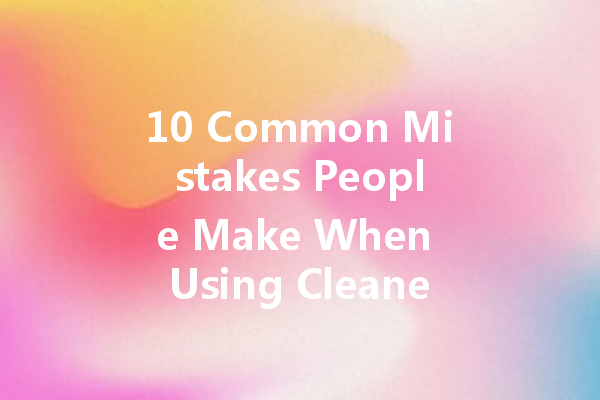Cleaning is an essential part of maintaining a healthy and hygienic environment, whether at home or in the workplace. However, many people make common mistakes that can hinder their cleaning efforts or even cause damage. Below, we’ll explore ten mistakes people often make when using cleaners and how to avoid them for optimal results.
One of the most common mistakes is neglecting to read the label on cleaning products. Each nettoyeur has specific instructions for use, dilution ratios, and safety precautions. Ignoring these details can lead to ineffective cleaning or even damage to surfaces.
How to Avoid It: Always take a moment to thoroughly read the label before using a cleaning product. Familiarize yourself with the directions, warnings, and recommendations to ensure safe and effective use.
Some individuals attempt to create super-cleaning solutions by mixing different cleaning products. However, this can be extremely dangerous. For example, combining bleach with ammonia produces toxic fumes that can pose serious health risks.
How to Avoid It: Never mix cleaning products unless explicitly stated on the label. Stick to using one product at a time, and opt for a tested combination if necessary.
Each cleaning product is formulated for specific surfaces or materials. For example, using an abrasive cleaner on delicate surfaces can cause scratches and deterioration.
How to Avoid It: Always choose a cleaner specifically designed for the surface you intend to clean. If you’re unsure, do a bit of research or test a small area first.
More is not always better when it comes to cleaning products. Overapplying a cleaner can lead to residue buildup, which can attract dirt and grime. Additionally, using excessive amounts can waste product and money.
How to Avoid It: Follow the recommended amount of cleaner on the label. Use just enough to cover the surface without leaving excess behind.
Failing to rinse off cleaning products properly can leave behind harmful chemicals or residue, harming both surfaces and health. This is especially important in food preparation areas.
How to Avoid It: After using a cleaner, ensure you rinse the area adequately with water, particularly in kitchens and bathrooms. Make it a habit to double-check that no residue remains.

Using dirty sponges, rags, or mops can transfer dirt and germs back onto surfaces. It is counterproductive and defeats the purpose of cleaning.
How to Avoid It: Regularly wash or replace your cleaning tools. Make sure they are clean before use, and designate specific tools for specific areas to prevent cross-contamination.
Cleaning products can react unexpectedly with certain surfaces, leading to discoloration or damage. Failing to test a cleaner can result in costly repairs.
How to Avoid It: Always conduct a spot test in an inconspicuous area before using a new cleaner on surfaces. This will help ensure that it doesn’t cause any adverse effects.
Many cleaning products contain harsh chemicals that can irritate the skin, eyes, or respiratory system. Not wearing gloves or masks can lead to health issues.
How to Avoid It: Always wear appropriate protective gear, such as gloves, masks, or goggles, especially when using potent cleaning products. Your safety should always be a priority.
Not all cleaners are created equal. Many people believe that any cleaner can serve any purpose, which can lead to misuse and frustration.
How to Avoid It: Understand the different types of cleaners available, such as disinfectants, detergents, and multipurpose cleaners. Choose the right product for your cleaning needs.
Many people spray a cleaner and immediately wipe it away. However, some products need time to break down dirt, grease, and grime effectively.
How to Avoid It: Follow the instructions for letting cleaners sit for the recommended amount of time. This ensures that they work effectively to break down stains and disinfect surfaces.
Conclusion
Cleaning effectively not only contributes to a healthier environment but also prolongs the life of your belongings. By avoiding these common mistakes and adhering to the guidelines mentioned above, you can achieve better results and make your cleaning routine more efficient. Happy cleaning!
